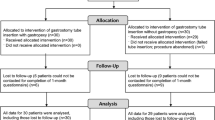Abstract
Purpose
The purpose of this study is to evaluate the short-term safety and efficacy of a co-axial angioplasty balloon technique for percutaneous radiologic gastrostomy catheter placement (PRG).
Methods
A total of 65 percutaneous radiologic gastrostomy tube placements were performed with the co-axial angioplasty balloon technique from 10/1999 to 1/2014. This included 19 females and 46 males between the ages of 20–83. Without the use of T-fasteners for gastropexy, the gastrostomy tube was placed over a catheter-shaft angioplasty balloon as a co-axial system. The angioplasty balloon was used to sequentially approximate the stomach wall to the abdominal wall, dilate the tract, and was then used as a dilator to aid gastrostomy tube advancement into the gastric lumen. Technical success, complications, and dislodgements were evaluated by means of retrospective review of patient medical records and imaging.
Results
There was no procedural failure in any of the 65 placements. 30-day follow-up was available for 56 patients. 7 patients died within 30 days; none of the deaths were recorded as procedure-related. There was 1 major complication (1.5%) consisting of a colocutaneous fistula. There were 4 minor complications (6.2%). There was no occurrence of bleeding or skin infection while using this technique.
Conclusions
PRG with the co-axial angioplasty-balloon technique is a safe and effective technique for gastrostomy placement.



Similar content being viewed by others
References
Preshaw RM (1981) A percutaneous method for inserting a feeding gastrostomy tube. Surg Gynecol Obstet 152(5):658–660
de Baere T, Chapot R, et al. (1999) Percutaneous gastrostomy with fluoroscopic guidance: single-center experience in 500 consecutive cancer patients. Radiology 210(3):651–654
Bazarah SM, et al. (2002) Percutaneous gastrostomy and gastrojejunostomy: radiological and endoscopic approach. Ann Saudi Med 22(1–2):38–42
Wollman B, D’Agostino HB (1997) Percutaneous radiologic and endoscopic gastrostomy: a 3-year institutional analysis of procedure performance. AJR Am J Roentgenol 169(6):1551–1553
Wollman B, D’Agostino HB, et al. (1995) Radiologic, endoscopic, and surgical gastrostomy: an institutional evaluation and meta-analysis of the literature. Radiology 197(3):699–704
Brown AS, Mueller PR, Ferrucci JT (1986) Controlled percutaneous gastrostomy: nylon T-fastener for fixation of the anterior gastric wall. Radiology 158(2):543–545
Ryan JM, Hahn PF, et al. (1997) Percutaneous gastrostomy with T-fastener gastropexy: results of 316 consecutive procedures. Radiology 203(2):496–500
Thornton FJ, Fotheringham T, et al. (2002) Percutaneous radiologic gastrostomy with and without T-fastener gastropexy: a randomized comparison study. Cardiovasc Interv Radiol 25(6):467–471
Kim JW, Song HY, et al. (2010) The one-anchor technique of gastropexy for percutaneous radiologic gastrostomy: results of 248 consecutive procedures. J Vasc Interv Radiol 19(7):1048–1053
Shin JH, Song HY, et al. (2010) Percutaneous radiologic gastrostomy: a modified Chiba-needle puncture technique with single gastropexy. Abdom Imaging 35(2):189–194
Durack JC, Wang JH, et al. (2013) Prospective evaluation of absorbable gastropexy anchor indwelling time in 33 patients. J Vasc Interv Radiol 24(9):1377–1380
Moote DJ, Ho CS, Felice V (1991) Fluoroscopically guided percutaneous gastrostomy: is gastric fixation necessary? Can Assoc Radiol J 42(2):113–118
Cardella JF, Kundu S, et al. (2009) Society of interventional radiology clinical practice guidelines. J Vasc Interv Radiol 20(7 Suppl):S189–S191
Dewald CL, Hiette PO, et al. (1999) Percutaneous gastrostomy and gastrojejunostomy with gastropexy: experience in 701 procedures. Radiology 211(3):651–656
Deutsch LS, Kannegieter L, et al. (1992) Simplified percutaneous gastrostomy. Radiology 184(1):181–183
Hicks ME, Surratt RS, et al. (1990) Fluoroscopically guided percutaneous gastrostomy and gastroenterostomy: analysis of 158 consecutive cases. Am J Roentgenol 154(4):725–728
Bell SD, Carmody EA, et al. (1995) Percutaneous gastrostomy and gastrojejunostomy: additional experience in 519 procedures. Radiology 194(3):817–820
Covarrubias DA, O’Connor OJ, et al. (2013) Radiologic percutaneous gastrostomy: review of potential complications and approach to managing the unexpected outcome. Am J Roentgenol 200(4):921–931
O’Keeffe F, Carrasco CH, et al. (1989) Percutaneous drainage and feeding gastrostomies in 100 patients. Radiology 172(2):341–343
Trerotola SO, Shah H, et al. (1998) Single-step dilation for large-bore percutaneous gastrostomy and gastrojejunostomy. J Vasc Interv Radiol 9(4):579–582
Itkin M, DeLegge MH, et al. (2011) Multidisciplinary practical guidelines for gastrointestinal access for enteral nutrition and decompression from the Society of Interventional Radiology and American Gastroenterological Association (AGA) Institute, with endorsement by Canadian Interventional Radiological Association (CIRA) and Cardiovascular and Interventional Radiological Society of Europe (CIRSE). J Vasc Interv Radiol 22(8):1089–1106
Author information
Authors and Affiliations
Corresponding author
Ethics declarations
Conflict of interest
The authors listed above declare that they have no conflict of interest.
Ethical approval
This article does not contain any studies with humans or animals performed by any of the authors. Therefore, informed consent was not obtained.
Rights and permissions
About this article
Cite this article
Bendel, E.C., McKusick, M.A., Fleming, C.J. et al. Percutaneous radiologic gastrostomy catheter placement without gastropexy: a co-axial balloon technique and evaluation of safety and efficacy. Abdom Radiol 41, 2227–2232 (2016). https://doi.org/10.1007/s00261-016-0808-6
Published:
Issue Date:
DOI: https://doi.org/10.1007/s00261-016-0808-6




